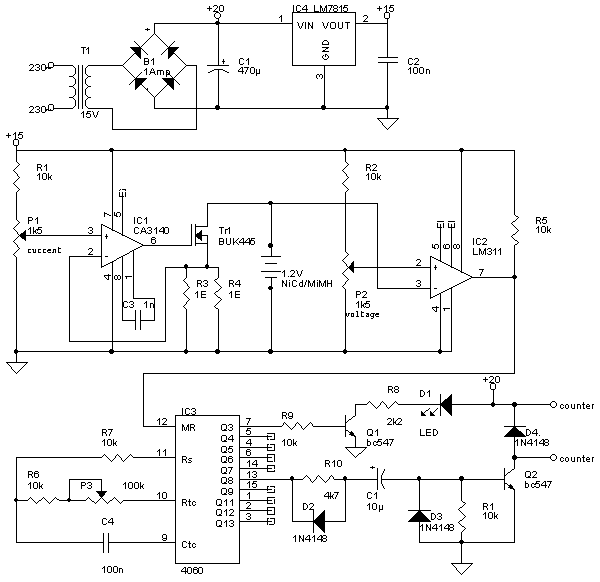![]() -MaH meter-
-MaH meter-
![]()
-Check the milli-Ampere-hour capacitance of your rechargeable
NiCad batteries-
Introduction
With this mAh meter you can check the mAh
capacitance of your NiCad or NiMH rechargeable batteries
Normally the cheaper NiCad AA-type cells have a
capacitance of 500-750mAh (NiCAD) the more expensive
NiMH AA-cells types are up to 1800mAh.
I built this circuit because the capacitance of
some of my older NiCad batteries seemed to be quite low, now I can
check their capacitance. It is also nice to
check if the new cells meet the specified capacitance!
Circuit description
IC1/TR1 builds a constant current sink which
will discharge the battery with a constant current of 500mA.
IC1 must be a so-called rail-to-rail opamp like
CA3140 of Intersil; a 741 will not work here!
TR1
can be any big- low ohmic mosfet. (The BUK455 in
the schematic is 100mohm).
The current "sink" must be adjusted to 500mA
with P1; TR1 must be put on a small heat sink.
IC2 checks the battery voltage; when it is too
low the output (pin 7) will become high. The trip level can be adjusted by
P2; I set the level on 800mV. The value is not
very critical because the voltage of a NiCAD cell drops very quickly
when it is almost empty.
IC3 is a pulse generator. It will generate
pulses as long as the battery voltage is higher than the trip level of
comparator IC2.
When the battery is discharged, MR (master
reset) of IC3 will be high and the IC will quit generating pulses.
The pulse frequency is set by P3; the frequency
must be set at 500 pulses per hour; with this setting the counter will display
the capacitance in mAh.
The network of diodes resistors and capacitors around Q2 creates a 200ms pulse
for the 24V-electro-mechanical 4-digit counter
which is
connected to the "counter" terminals.
D4
protects Q2 against the high voltage spikes from
the counter magnetic coil.
The LED will blink at a fast rate when the counter is running
mAh meter schematic:

Circuit adjustment & application
Now the circuit is ready for use: when you insert
a freshly charged battery, the LED will start blinking and the counter
will start counting. After some time (1-3 hours) the battery is discharged
ad the counter will stop. The readout of the counter
indicates the capacitance of the battery in mAh
When you use a different current setting the
pulse frequency must be changed accordingly.
The circuit can also be used to check other
batteries ;you will have to change the trip level and current sink setting to
the
size and the voltage of the battery.
Note that the current sink remains active when
the trip level is reached. This is not a problem for NiCAD / NiMH cells,
but
lead based batteries (car batteries) can be ruined when they are discharged too
deep !
To prevent this you can put about 10 power diodes in series with the car
battery, this way the voltage will always remain above 6-8 Volts.
→ Download specifications of key components at the Component specs page